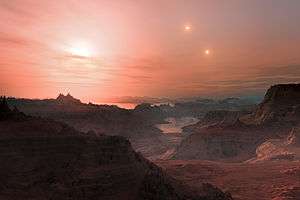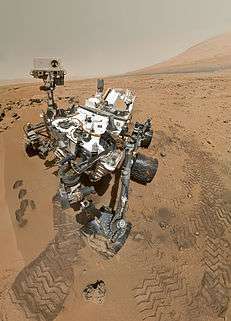HD 40307 e
| Exoplanet | List of exoplanets | |
|---|---|---|
| Parent star | ||
| Star | HD 40307 | |
| Constellation | Pictor | |
| Right ascension | (α) | 05h 54m 04.2409s[1] |
| Declination | (δ) | −60° 01′ 24.498″[1] |
| Apparent magnitude | (mV) | 7.17[1] |
| Distance | 41.8 ± 0.3 ly (12.83 ± 0.09[1] pc) | |
| Spectral type | K2.5V[1] | |
| Radius | (r) | 0.716 ± 0.010[2] R☉ |
| Temperature | (T) | 4977 ± 59[3] K |
| Metallicity | [Fe/H] | −0.31 ± 0.03[3] |
| Age | 1.2 (≥ 0.2)[4] Gyr | |
| Orbital elements | ||
| Semi-major axis | (a) | 0.1886 [0.1782, 0.1969][5] AU |
| Eccentricity | (e) | 0.06 [0, 0.18][5] |
| Orbital period | (P) | 34.62 [34.42, 34.83][5] d |
| Semi-amplitude | (K) | 0.84 [0.53, 1.16][5] m/s |
| Physical characteristics | ||
| Minimum mass | (m sin i) | 3.5 [2.1, 4.9][5] M⊕ |
| Discovery information | ||
| Discovery date | October 28, 2012 | |
| Discoverer(s) | Mikko Tuomi et al. | |
| Discovery method | radial velocity, using HARPS | |
| Discovery site | La Silla Observatory, Chile | |
| Discovery status | Announced[5] | |
| Database references | ||
| Extrasolar Planets Encyclopaedia | data | |
| SIMBAD | data | |
| Exoplanet Archive | data | |
| Open Exoplanet Catalogue | data | |
HD 40307 e is an extrasolar planet orbiting the star HD 40307. It is located 42 light-years away in the direction of the southern constellation Pictor. The planet was discovered by the radial velocity method, using the European Southern Obervatory's HARPS apparatus[5][6][7] by a team of astronomers led by Mikko Tuomi at the University of Hertfordshire and Guillem Anglada-Escude of the University of Goettingen, Germany.[8]
Its minimum mass is 3.5 that of Earth - the smallest - and dynamical models suggest it cannot be much more (and so is measured close to edge-on).[5] It further gets roughly the same insolation from its star as Mercury gets from the Sun.[9] Planets like this in that system have been presumed "super-Earth".[3]
However planets b, c, and d are presumed to have migrated in from outer orbits; and planet b is predicted a sub-Neptune.[10] It is likely that this planet formed even further out. Whether it is a sub-Neptune, a super-Venus or even a super-Mercury is unknown.
References
- 1 2 3 4 5 "HD 40307". SIMBAD. Centre de Données astronomiques de Strasbourg. 2008. Retrieved 18 June 2008.
- ↑ HD 40307, entry, CDS database J/A+A/450/735; described in Effective temperature scale and bolometric corrections from 2MASS photometry, E. Masana, C. Jordi, and I. Ribas, Astronomy and Astrophysics 450, #2 (May 2006), pp. 735–746. Bibcode: 2006A&A...450..735M. doi:10.1051/0004-6361:20054021.
- 1 2 3 M. Mayor; S. Udry; C. Lovis; F. Pepe; D. Queloz; W. Benz; J.-L. Bertaux; F. Bouchy; C. Mordasini; D. Segransan (2009). "The HARPS search for southern extra-solar planets. XIII. A planetary system with 3 Super-Earths (4.2, 6.9, & 9.2 Earth masses)". Astronomy and Astrophysics. 493 (2): 639–644. arXiv:0806.4587
 . Bibcode:2009A&A...493..639M. doi:10.1051/0004-6361:200810451.
. Bibcode:2009A&A...493..639M. doi:10.1051/0004-6361:200810451. - ↑ HD 40307, database entry, Geneva-Copenhagen Survey of Solar neighbourhood, J. Holmberg et al., 2007, CDS database V/117A, accessed November 19, 2008; described in The Geneva-Copenhagen survey of the Solar neighbourhood. Ages, metallicities, and kinematic properties of ~14 000 F and G dwarfs, B. Nordström, M. Mayor, J. Andersen, J. Holmberg, F. Pont, B. R. Jørgensen, E. H. Olsen, S. Udry, and N. Mowlavi, Astronomy and Astrophysics 418 (May 2004), pp. 989–1019, Bibcode: 2004A&A...418..989N, doi:10.1051/0004-6361:20035959.
- 1 2 3 4 5 6 7 8 Tuomi, Mikko; Anglada-Escude, Guillem; Gerlach, Enrico; Jones, Hugh R. R.; Reiners, Ansgar; Rivera, Eugenio J.; Vogt, Steven S.; Butler, R. Paul (2012). "Habitable-zone super-Earth candidate in a six-planet system around the K2.5V star HD 40307". arXiv:1211.1617v1
 [astro-ph].
[astro-ph]. - ↑ Wall, Mike (November 7, 2012). "'Super-Earth' Alien Planet May Be Habitable for Life". Space.com. Retrieved November 8, 2012.
- ↑ Tate, Karl (November 7, 2012). "Super-Earth Planet: Potentially Habitable Alien World Explained (Infographic)". Space.com. Retrieved November 8, 2012.
- ↑ Murrin, Marc (November 8, 2012). "Astronomers discover a potentially habitable Super-Earth HD 40307g (Infographic)". tech-stew.com. Retrieved November 8, 2012.
- ↑ Tuomi, Fig. 17
- ↑ Barnes, R.; Jackson, B.; Raymond, S.; West, A.; Greenberg, R. (2009). "The HD 40307 Planetary System: Super-Earths or Mini-Neptunes?". The Astrophysical Journal. 695 (2): 1006. arXiv:0901.1698
 . Bibcode:2009ApJ...695.1006B. doi:10.1088/0004-637X/695/2/1006.
. Bibcode:2009ApJ...695.1006B. doi:10.1088/0004-637X/695/2/1006.
External links
- "Super-Earth Discovered in Star's Habitable Zone". Exoplanets.
Coordinates: ![]() 05h 54m 04.2409s, −60° 01′ 24.498″
05h 54m 04.2409s, −60° 01′ 24.498″

